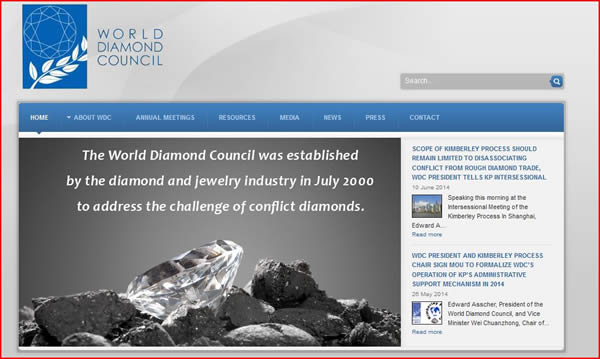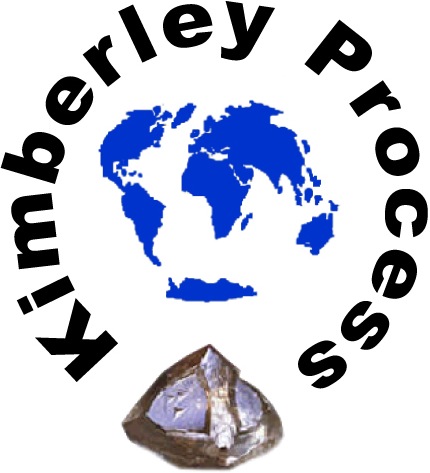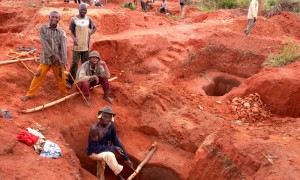The System of Warranties (SoW) in the diamond industry dates back to 2002, when the World Diamond Council (WDC) in team with the World Federation of Diamond Bourses (WFDB) and the International Diamond Manufacturers Association (IDMA) launched this package of measures to strengthen the Kimberley Process Certification Scheme (KPCS) as a voluntary pattern of industry self-regulation aimed at weeding out conflict diamonds from the supply chain.
The annual general meeting of the WDC recently held in Dubai was focused on broadening the scope of the KPCS and formalizing principles related to the “duty of care” for responsible business practices in the framework of the System of Warranties. In this interview given to Rough&Polished, Stephane Fischler, Acting President of the WDC shares his views on the issues raised during the two-day event.
The World Diamond Council annual general meeting in Dubai discussed propositions to broaden the scope of the Kimberley Process Certification Scheme to enhance prevention and reduce the risk of systemic violence and conflict. Was any final decision taken in this regard and how this may be done?
In 2012, during its AGM in Vicenza, the WDC took a very clear position to broaden the scope of the KPCS and proposed a new definition for the term “conflict diamond” to include “diamond-related violence in rough diamond producing and trading areas”. This remains our position today. We believe that an agreement around broadening the scope is the best way to work preventively in lowering the risk of conflict and give a much better chance to sustained development. At the same time, we need to talk more inside the industry about how to provide confidence in all spheres—providing adequate protection to all stakeholders and in particular the most vulnerable. We as an industry should provide more guarantees to the final consumer. That is our responsibility.
The WDC concluded its meeting noting that extensive and constructive discussions spanned issues and opportunities for the diamond industry to ensure that no diamond is linked to conflict or human rights abuses. Does it mean that the definition of “conflict diamonds” has been extended to include human rights violations as well?
 Discussions followed throughout the two-day meeting, focused on various ways to strengthen the integrity of the complex diamond supply chain. This included ideas to broaden the scope of the KPCS to enhance prevention and reduce the risk of systemic violence and conflict. Members also explored, besides the standards of industry initiatives such as the Responsible Jewellery Council, universally accepted approaches towards responsible business conduct (such as those proposed by the Organization for Economic Co-operation and Development) that should be incorporated into existing due diligence systems. The approaches will enhance awareness and responsibility of all participants in the diamond supply chain. We need to ensure that all involved in the diamond industry benefit for the long term. Again, the focus is on preventing violence and that all involved benefit for the long term.
Discussions followed throughout the two-day meeting, focused on various ways to strengthen the integrity of the complex diamond supply chain. This included ideas to broaden the scope of the KPCS to enhance prevention and reduce the risk of systemic violence and conflict. Members also explored, besides the standards of industry initiatives such as the Responsible Jewellery Council, universally accepted approaches towards responsible business conduct (such as those proposed by the Organization for Economic Co-operation and Development) that should be incorporated into existing due diligence systems. The approaches will enhance awareness and responsibility of all participants in the diamond supply chain. We need to ensure that all involved in the diamond industry benefit for the long term. Again, the focus is on preventing violence and that all involved benefit for the long term.
Could you disclose the essence of discussions around the WDC System of Warranties (SoW) and describe the principles related to the “duty of care” for responsible business practices in the diamond supply chain?
The term “duty of care” was introduced during a seminar around conflict minerals co-organized by one of our member organizations, CIBJO. The duty of care relates to the responsibility of each player in the value chain to trade only with responsible parties that can demonstrate their adherence to universally accepted ethical and responsible business practices. It means asking questions and looking for solutions. It means that when a transaction is clearly associated with parties committing or contributing to fund violence, we need to just say ‘no’ and the transaction shouldn’t take place.
At the Kimberley Process Intersessional Meeting in Perth last year, it was said that the then existing System of Warranties was far from being perfect and there was a hope to update it by the end of this year. Were there any new elements introduced in it and to what effect?
 Indeed, the WDC System of Warranties (SoW) was also reviewed during the WDC General Annual Meeting that included all major member-based industry organisations: CIBJO, IDMA, WFDB and USJC. Consensus was reached to formalize principles related to the “duty of care” for responsible business practices. The principles are intended to raise awareness around universal norms of business conduct and current legal obligations and incorporate more assurances as recommended by various governance-related international and national treaties. Principles should be easily incorporated into any size organization, including small and medium sized businesses.
Indeed, the WDC System of Warranties (SoW) was also reviewed during the WDC General Annual Meeting that included all major member-based industry organisations: CIBJO, IDMA, WFDB and USJC. Consensus was reached to formalize principles related to the “duty of care” for responsible business practices. The principles are intended to raise awareness around universal norms of business conduct and current legal obligations and incorporate more assurances as recommended by various governance-related international and national treaties. Principles should be easily incorporated into any size organization, including small and medium sized businesses.
By far not every diamond jewelry buyer is aware of the System of Warranties. What is done by the WDC to enlighten the general public about it and in what practical way may the SoW be used by diamond jewelry retailers to give guarantees to their customers?
You are right. Retailers are not sufficiently informed about our commitments. This is certainly the focus of our efforts and communication strategy for the coming months. We will create communication toolkits for the jewelers associations to allow them to better inform their members. It’s crucial everybody feels confident that their suppliers use the SoW and showcase their due-diligence to provide and spread all necessary assurances. Again, as I already said, we as an industry should provide more guarantees to the final consumer.
As it appears, the Dubai Diamond Conference is not the first to point to the need for a reform of the Kimberley Process. What are the aspects of such a reform voiced by the industry stakeholders this time?
The main reforms are focused on the need to broaden the scope, establishing a permanent secretariat, review the current KPCS core document and standards and the functioning of the peer review system. We must define what has worked well and what was badly designed. I hope that an inclusive and respectfully managed review process can achieve further progress for the future. It’s also important to highlight that despite the fact that it’s not perfect, the KP has been so far comparatively very successful.
What is the current role played by NGOs in the Kimberley Process and have they finally come to terms with this organization regarding its principal policies?
I guess you should better ask them this question. For us they are full partners in the scheme and an essential support on the ground.
The Central African Republic was allowed by the Kimberley Process to export diamonds from its KP-compliant areas, but the general situation there seems to be shaky. What are the steps taken by the KP to prevent contamination of the diamond pipeline with conflict diamonds coming from the country’s non-compliant areas?
 As you know, the CAR is under strict monitoring by the KP. A monitoring Team constituted of relevant KP working groups and representative of the Civil Society and WDC is working under pre-established Terms of References and an operational framework that guide their work in allowing exports exclusively from mining zones where the absence of conflict is established, free access to all communities and with required traceability. There are currently five so-called “green” zones in the West of the country that are authorized to export. No zones in the rest of the country including the East is yet authorized to export. The traceability requirements are very strict and allow for prevention of contamination. We do however follow the evolutions in the country very closely.
As you know, the CAR is under strict monitoring by the KP. A monitoring Team constituted of relevant KP working groups and representative of the Civil Society and WDC is working under pre-established Terms of References and an operational framework that guide their work in allowing exports exclusively from mining zones where the absence of conflict is established, free access to all communities and with required traceability. There are currently five so-called “green” zones in the West of the country that are authorized to export. No zones in the rest of the country including the East is yet authorized to export. The traceability requirements are very strict and allow for prevention of contamination. We do however follow the evolutions in the country very closely.
Are there any other sources of ‘conflict diamonds’ arousing concern of the Kimberley Process?
No, not currently. However, the importance of the KP and the WDC remains crucial when it comes down to the future, as there are still areas where diamond mining may take place that suddenly become involved in armed conflict. There will always be new challenges, and we stand ready to address them.
The Kimberley Process will finally have its Permanent Secretariat based on the decision of the WDC Board at this year’s meeting. What are the functions and tasks facing it in the near future?
We hope that, together with others, we can convince the KP members to agree on the principle to establish a Permanent Secretariat. The main goals are to guarantee institutional memory, garner and manage KP related data, provide technical assistance and capacity building in the ASM sector, enhance KPCS implementation and of course professionally support the work of the KP Chair and Vice Chair as well as the KP Working Groups. One important issue however should be considered, according to the WDC. A mandate for the chairs of 1 year is very short to allow for continuous and strong improvements.

